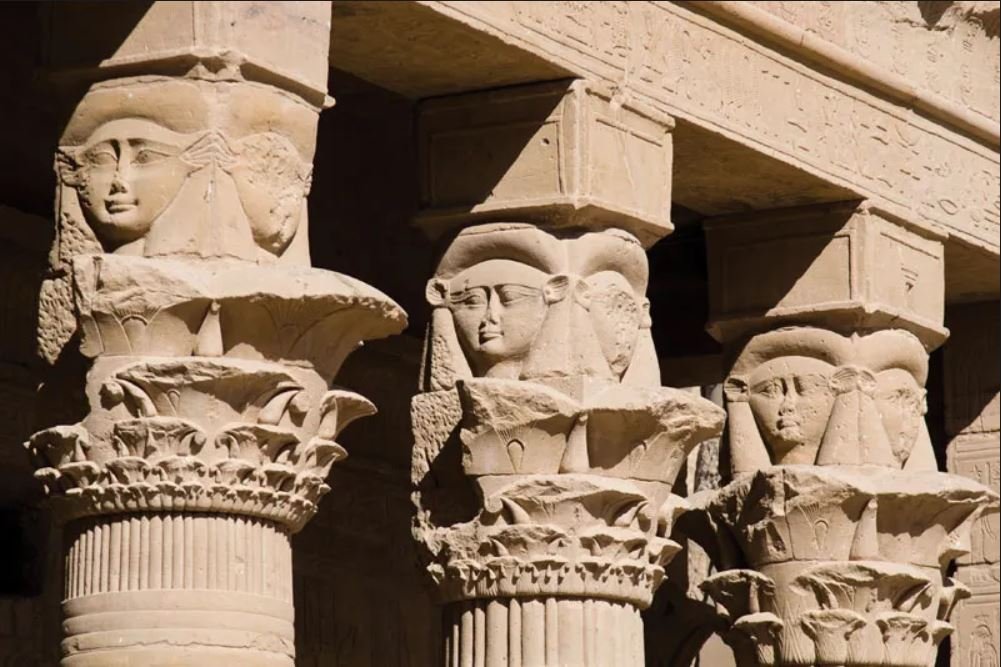5 information about Wonderful Dendera Temple:Abode of Love.
Dendera Temple: An architectural marvel honoring Hathor, where love’s anthems blend with the mysteries of the cosmos.
Tucked away near the banks of the Nile in Upper Egypt is the splendid Temple of Dendera, one of the best-preserved temple complexes in the nation. Dedicated to Hathor, the ancient Egyptian goddess of love, music, and motherhood, this temple stands as a testament to the cultural and religious significance of this deity and the unparalleled craftsmanship of ancient Egyptian builders.
Historical Overview
The temple complex at Dendera is quite large, with a basilica, two birth houses, a sacred lake, and numerous other temples and shrines within its walls. The structures on the site date from various ancient Egyptian eras, including monuments from the Middle Kingdom, the Ptolemaic Era, and the period of Roman provincial rule.
There is evidence that the first building on the site was constructed around 2250 BCE, but the remaining structures date primarily from the Ptolemaic period. When the site was rediscovered in 1995 BCE, construction on the Mentuhotep II monument, the oldest existing structure, was most likely underway. The Mentuhotep Monument has since been relocated to Cairo. The oldest structure still standing is that of Nectanebo II, who built it around 345 BCE. All that being said, it may be more accurate to say that the structure as we know it began in 54 BCE, with the construction of the Temple of Hathor, the most prominent structure in the Dendera complex.
The Dendera Temple Complex covers approximately 40,000 square meters and is surrounded by a large mudbrick wall. While the present structure mainly dates back to the Ptolemaic and Roman periods, the history of religious worship at this site is much older, possibly extending back to the Old Kingdom.
Architectural Splendor
This site served as a center for the Hathor cult. During the Happy Reunion, Hathor was said to travel from her temple in Dendera to her husband Horus’ temple in Edfu to spend time with him. This “reunion” took place every year, and the return of Hathor to Dendera was thought to mark the official start of the Nile’s flood season.
Upon entering the temple complex, one is immediately struck by the grandeur of the main temple. The façade is characterized by a massive façade filled with carvings and, most notably, six Hathoric columns – pillars topped with the face of Hathor.
Inside, the temple boasts a magnificent hypostyle hall, chapels, sanctuaries, and a sacred lake. The ceiling of the main hall is particularly noteworthy. It’s adorned with exquisite astronomical representations, showcasing the detailed knowledge ancient Egyptians had of the cosmos.
Hathor: The Heart of Dendera
The temple’s primary dedication to Hathor is evident in its art and carvings. Hathor, often depicted as a cow goddess or a woman with cow ears, was considered a motherly figure, a nurturer, and a protector of women. She was also the goddess of music, dance, and joy.
In the temple, her story intertwines with that of other deities, such as Horus. One of the most famous depictions is the yearly celebration of the reunion between Hathor and Horus, symbolizing the cycle of life and death.
 The Mysterious Zodiac
The Mysterious Zodiac
One of the most intriguing aspects of the Dendera Temple is the famous Dendera Zodiac. Located in one of the chapels, this bas-relief carving represents the earliest known depiction of the zodiac in history. It features the traditional zodiacal constellations, along with Egyptian gods and goddesses. This zodiac was a source of intrigue and was taken to France in the 19th century, where it’s now displayed at the Louvre.
Visiting Dendera
The temple complex, being one of the less frequented by the throngs of tourists that visit Egypt annually, provides a serene experience. Its relative solitude allows for a more reflective exploration, where one can truly soak in the architectural and spiritual wonders it presents.
The Zodiac of Dendera was transported to France in 1821 with permission from Mohamed Ali Pasha, Egypt’s Turkish viceroy at the time. The Egyptian government has requested its return. It is currently on display at the Louvre in Paris.
In Conclusion
The Dendera Temple to Hathor provides a beautiful blend of history, mythology, and astronomy, all set within the architectural genius of ancient Egyptian builders. As one wanders its halls and corridors, it’s easy to feel the pulse of ancient rituals and the echoes of celebrations dedicated to the divine Hathor. It’s not just a temple; it’s a journey through time, space, and faith.


Comment (0)